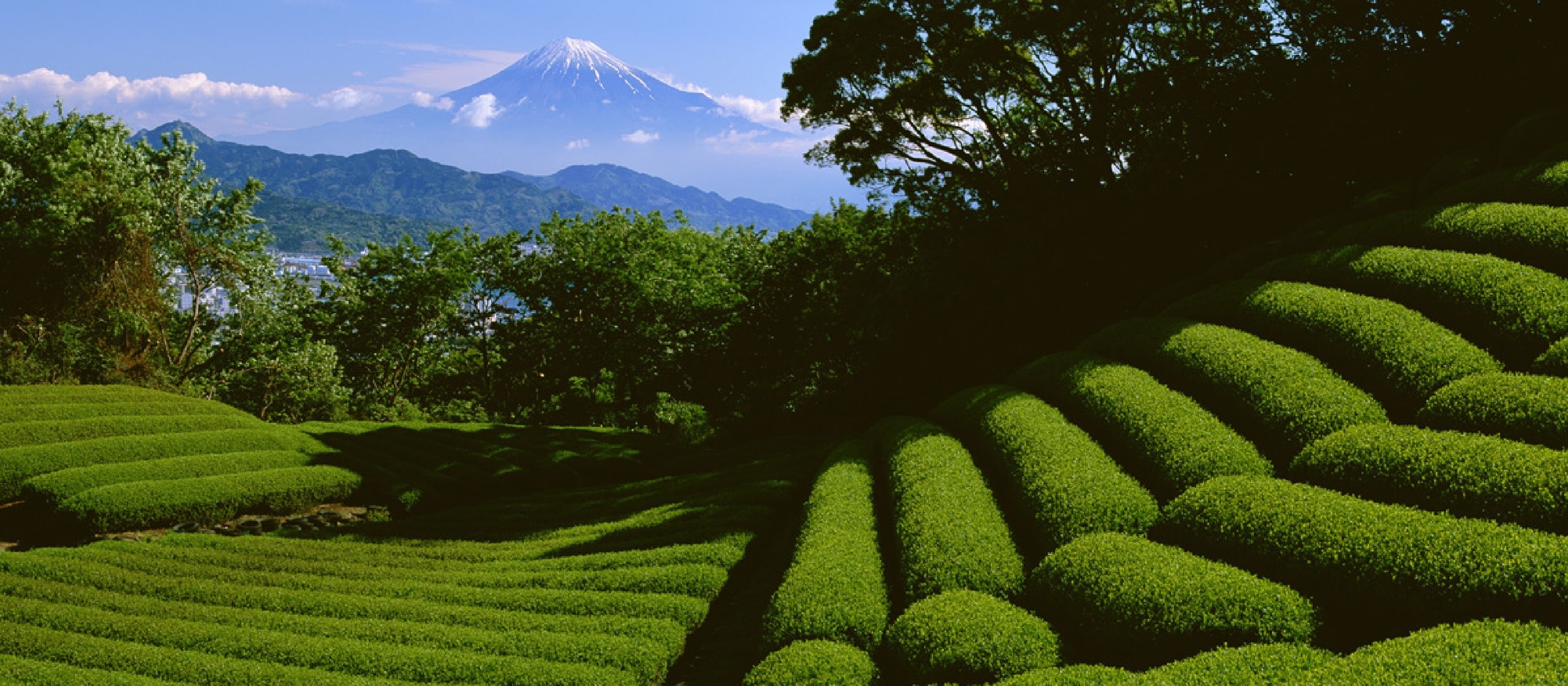日本茶について About Japanese tea 有關日本茶 일본차의유래
- 日本語
- English
- 中文
- 한국
我国ではお茶がまだ中国から来る船でしか手に入らなかった奈良時代には現在のような嗜好品ではなく、医薬品として扱われ大変貴重な存在でした。当然、手に入る量も少なく、貴族や高僧など一部の人々のみに限られて飲まれていました。
平安時代に中国からの帰国僧によりお茶の種子が日本に持ち込まれ、鎌倉時代には静岡県や京都府、福岡県、鹿児島県などの主要な茶産地でもお茶が栽培されはじめました。また、この頃には、粉状の茶を湯で溶かし茶筅で練って飲むという今日飲まれているような抹茶の飲み方『抹茶法』を栄西禅師が中国で学び、日本に伝えたことにより、武家社会を中心に抹茶が広がっていきました。一般の庶民がお茶を口にするようになったのは江戸時代といわれており、番茶に近いお茶を煮出して飲んでいたようです。現在飲まれているような緑色をした煎茶は江戸中期に宇治田原町の永谷宋円が発案しました。
近年、大学等の研究機関により緑茶の持つ様々な機能性が明らかになり、健康的効果を期待できるものとしての需要が高まりつつあります。
長い伝統の中で日本茶が昔も今も変わらずに飲み続けられているのは、緑茶が人々にとって心にも体にも優しい飲み物だったからでしょう。
Back in the Nara period (710 –794) in Japan, a time when tea could only enter Japan via ships arriving from China, tea leaves weren't seen as the luxury items that they are today, but rather were seen as incredibly precious medicinal ingredients.
Naturally, this meant that the amount of tea that could be obtained was very low and those who could drink it was limited to members of the nobility and high ranking priests.
During the Heian period (794 –1185), monks returning from
China brought tea seeds back with them to Japan, which led to the creation of major tea production sites in Shizuoka, Kyoto, Fukuoka, and Kagoshima during the Kamakura period (1185 –1333). Also around this time the method of tea preparation
known as 'Matcha', which involves the dissolving of powdered tea leaves in hot water before beating with a tea whisk, was brought to Japan by the monk Eisai, who learned about the technique while in China. Once it made it to Japan, matcha
quickly spread throughout the samurai class. It is said that it was not until the Edo period (1603 –1868) that tea became widely enjoyed by the common folk, when a variety of tea similar to today's 'bancha' was regularly boiled down and
consumed. The variety of tea commonly consumed in Japan in the present day known as 'sencha', with its distinctive green coloration, was developed by Nagatani Soen from the town of Ujitawara around the mid-Edo period.
In recent years
the various positive effects of green tea on our health have been made known through research by universities and other such institutions, which has led to increased demand for the product from consumers.
It would be no exaggeration
to say that the enduring popularity of Japanese tea throughout the ages and to the present day is thanks to how kind green tea is to our minds and bodies.
在日本,奈良时期只有来自中国的船只才能带来茶,而茶并不像今天这样被当成一种嗜好品,而是被视为一种药物,而且具有极高的价值。当然,当时可以取得的数量很稀少,仅限于贵族籍及高僧等人才能饮用。在平安时期,从中国归国的僧侣将茶叶的种子带回日本。在鎌仓时期,开始在静冈县、京都府、福冈县和鹿儿岛县等主要茶叶种植区域开始种植茶叶。同一时期,荣西禅师在中国学会像现在饮用抹茶的方法,将粉末茶溶解在热水中,并用茶筅在茶碗中搅拌均匀,从此以武家社会为中心,抹茶开始广为流传。据说一般民众在江户时代才开始喝茶,刚开始他们似乎是将接近番茶的茶叶用煮的方式开启饮茶经验。现代喝到的绿色煎茶,则是在江户时代中期由宇治田原町的永谷宋円发明的。近年来,大学等研究机构对绿茶的各种功能进行验证,证实绿茶对健康的益处越来越大。在悠久的传统中,日本茶从古至今始终没变,还是持续被大家所喜爱饮用,可能就是因为绿茶是一种对心灵和身体都有益的饮料吧!
중국에서오는 배로밖에 구입할수없는 나라시대(710-794)의차는 , 지금처럼 즐겨마시는차가아니라 의약품으로서
사용되는 대단히귀중한 존재이었습니다.
당연히 구입할수있는 양도 적고 귀족이나 고승등 일부사람들만이 마실수있었습니다.
평안시대(794-1185)에 중국에서 귀국하는 고승이 차종자를 일본으로 가져오게되어 가마쿠라시대에는
시즈오카,교토,후쿠오카,가고시마 등의 중요한 차산지에서 차재배가 시작되었습니다.
또한 그시대에 분말상태의 차를 뜨거운물로 녹여서 차센으로 저어서 마시는 현재의 <말차마시는방법>
을 송서스님이 중국에서 배우고귀국하여 일본에펼침으로서 무사계급들 중심으로 말차가 널리 알려지게되었습니다.
일반서민이 차를 마시게된것은 에도시대(1603-1868)로 알려져있으며 반차와비슷한 차를 끓여서 마신것같습니다.
현재 마시고있는녹색 센차는 에도시대에 우지다하라마을에사는 "나가타니소엥"이라는 사람의 발안입니다.
요즘 대학교등 연구기관에의해 녹차가 가지고있는 여러가지 효과가 밝혀지면서 건강을위한차로서 선호력이
높아지고있습니다.
오래된전통속에서 일본차가 옛시절이나 지금도 변함없이 계속이어지고있다는것은 녹차가 사람들한테 심신적으로
좋기 때문이겠지요.

